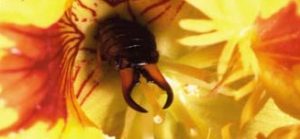Plenty of things “go in one ear and out the other,” but earwigs aren’t one of them. Okay, it’s possible—though not at all likely—that one might snuggle in your ear while you snooze. Earwigs are attracted to small, shady spaces, but despite their name, they have no special interest in ears. In fact, they’re much more likely to nestle their flat bodies under stones or tree bark.
 And don’t worry about the large pincers, or cerci, at the back end of an earwig. They can deliver a pinch, but it’s usually too weak for you to feel. Some kinds of earwigs curve upward like scorpions and use their cerci to threaten—or wound—insects, spiders, and occasionally, small birds. Other kinds squirt a bad-smelling liquid at their enemies.
And don’t worry about the large pincers, or cerci, at the back end of an earwig. They can deliver a pinch, but it’s usually too weak for you to feel. Some kinds of earwigs curve upward like scorpions and use their cerci to threaten—or wound—insects, spiders, and occasionally, small birds. Other kinds squirt a bad-smelling liquid at their enemies.
Earwigs grow by molting, shedding their old coats when tight and growing new ones. Most molt four to six times before becoming adults and developing wings. They sprout two pairs: a small, thick pair and a large, thin pair shaped like ears. The small wings cover and protect the large, folded ones until they open for flight. Not every earwig species grows wings and those that do seldom fly. Instead, they scurry around on all six legs, feeding mostly on dead or decaying plants and different kinds of insect larvae.
Even without flying, earwigs have managed to travel the world, tucked inside luggage, newspaper bundles, food cartons, and crates of building supplies. One toured the international postal system inside a letter! Of course, earwigs don’t plan these trips. They just happen to settle into some cracks and crevices that get moved around a lot. That’s likely how European earwigs came to North America in the first place.
Quick Earwig Facts
- Sometimes hundreds of earwigs mass beneath a single rock.
- Always on guard, the earwig keeps its antennae in touch with its surroundings while it rests.
- As it’s hatching, an earwig uses a special “tooth” to break out of its egg.
- The females of some earwig species make surprisingly good moms. They are one of the few kinds of insects that clean and protect the eggs they lay, then care for their newly-hatched nymphs.
- Even after death, a mother earwig may continue to help her young by becoming a nutritious dinner for them.
Folklore
The earwig has frightened folks in many parts of the world. Some believed it would wriggle its way through their ears and into their brain. Others blamed the insect for their loss of hearing and tried to cure themselves with a “medicine” made of dried, powdered earwigs mixed with urine from hares!
https://www.youtube.com/watch?v=95BgMEsYtdY
